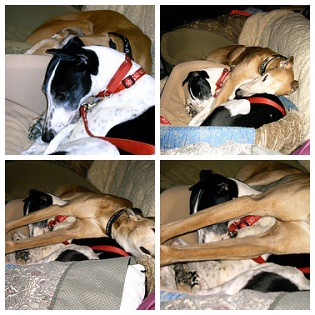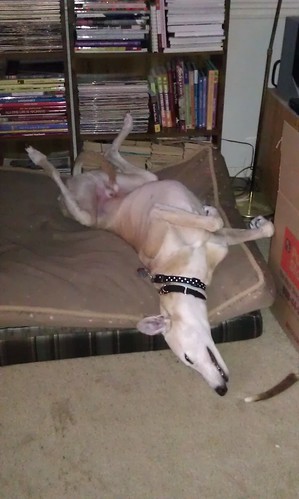 Why I don't have to groom my dogs* at home...
Why I don't have to groom my dogs* at home...Greyhounds don't have enough hair to cut!
A
blogger who has
two Scottish Terriers--one a new rescue--was asking for advice about clippers so she could groom her dogs at home. I posted a nice, long answer (you know how wordy I can be)--and her spam filter ate my response. (The response included an Amazon link to a suitable pair of clippers. That link probably pissed off the spam filter.)
To prevent a repeat occurrence, I'm posting my message here--links and all, and I'll let Mary come here to find the info. (Take
that, you pissy spam filter!)
So here goes: Scotties don't have super-thick coats, and as long as the dogs are being brushed and combed regularly, Mary, you can get by well with a
single-speed Andis Clipper. (Most groomers are fans of Andis clippers for their reliability.) For Scotties, you won't need the extra power of a two-speed clipper. You'll want to avoid clippers with fixed blades, and go with one that has interchangeable blades. (The clipper at that link comes with an interchangeable #10 blade. Other blades can be ordered separately.)
Clippers with detachable blades can use blades from another manufacturer. Thus, Andis, Oster, Wahl, Laube, etc.--blades and clippers can be switched around. (I use Andis clippers with blades from everyone.)
You also will want a set of detachable snap-on combs for your clippers. Like the blades and clippers, snap-on combs from one company work with clippers made by another. The combs don't fit all blades (some blades are longer than others), but they will fit over any #10 (like the one that comes with the clippers). Most combs have springs in them to keep them on the clipper. To attach a comb, put the bottom/back latches against the bottom of the clipper blade. Push the comb "forward" (compressing the spring) until the front part of the comb slips over the front of the blade. To remove the comb, push it forward until you can disengage the comb from the front of the blade. You can do all this while the blade is on your clippers. It's much easier to do it that way than to do it on a blade that's free in your hand.
I know you have a
diagram of the pattern lines for Scotties. For the dogs' heads and ears, you can use the #10 blade as it is. This will give a neat, tight result.
Always use the clippers with the grain of the dog's coat! You can brush hair against the grain to make it stand up for better clippering. But if you clipper against the grain, you'll be cutting the hair noticeably shorter than it is when cut with the grain. A #10 against the grain will be the equivalent of a pre-surgery shave at the vet's office--way too short for a pet cut.
For a slightly longer length on the dogs' backs, you can use a short snap-on comb over the 10 blade; you'll use a longer snap-on comb to blend from the back into the skirt and down the legs. Use the 10 blade (without a comb) to trim the sanitary area and shave around the pads of the dogs' feet to get rid of excess hair there. The dogs' hair should be clean, dry, and combed out before you begin the haircut.
Watch the temperature of the 10 blade. The longer it's used, the warmer it will get. Test it against the inside of your wrist, just like you used to test baby formula. (Using a single-speed clipper means the blade won't get hot as fast as it would with a two-speed.) You can buy coolant sprays (like
Cool Care), or you can just take breaks while the blade cools down (put it on a piece of ceramic tile to cool it more quickly), or you can buy an extra blade and be prepared to swap between the two. You can continue to use a warm blade under a snap-on comb because the comb will touch the dog--not the blade. But be sure the blade is cool when you're using it against the dog's skin (for the head, ears, pads, and sanitary). Keep blades clean and oiled so they cut well (brush loose hair out of the blade with an old toothbrush; oil for the blades usually is included in clipper kits). When even a clean blade won't cut well, you can send it out to be sharpened. If a blade has been dropped or banged up, teeth can break off, so check the teeth before you begin any cut. A blade with a broken tooth can be used under a snap-on comb, but it cannot safely be used against the dog's skin.
You will also want a couple of pairs of shears (i.e., scissors). Thinning shears are great for blending along the edge of the skirt. Straight shears are good for trimming and shaping the tail, trimming the eyebrows; a really short pair of shears is nice for edging the ears. (Edging the ears is tricky. Safest method is to put your thumb and finger on the skin of the ear, slightly extending past the dog's skin. Then trim against your thumb and finger. That's the safest way to ensure you aren't going to cut the skin.) And don't forget to leave that traditional tuft of hair at the base of the Scottie's ear!
If you have a PetSmart nearby, feel free to drop in and ask for advice from the groomers. (Hint: Don't drop by on a weekend, when they're slammed. But maybe a quiet evening...) Ask them where they send their blades and shears for sharpening. Maybe ask them to show you how to put on the snap-on combs, if my description didn't make sense. I don't know how private grooming salons feel about potential customers going into do-it-yourself mode, but PetSmart groomers usually don't mind customer questions; since PetSmart also sells clippers and shears, it's good customer service to answer questions. (P.S. Barbers and beauty salons also have to send blades and shears out for sharpening, so you might get a good reference from one of them, too.) Around here (metro Atlanta area), sharpening generally runs about $6-$7 a piece--maybe a little less for blades, more for shears. New #10 blades run about $20. Try to avoid dropping blades or shears--it can knock them out of alignment or even break them outright. If your shears bend the hair instead of cutting it, it's time to send the shears off to an expert for adjustment and sharpening. Also, most PetSmarts have grooming salons with windows. You might not be lucky enough to be in the store when they're grooming a Scottie, but watching through the window as a Schnauzer or Westie gets a haircut might be useful.
Never cut out mats with scissors. Use the clippers and your #10 blade if you can't comb it. Be careful with the clippers anywhere there are thin folds of skin: under the arms, along the tuck-up, on the ears. (Clipper ears from the center of the ear-leather toward the edge, then edge the ears with shears.)
So this is sort of Grooming 101. If any of my readers has a question, just ask. If you stumble across this post more than three days from today, your post won't appear until I "moderate" it; but I'll get an email notification, and I'll answer you as soon as I can.
*The red-fawn greyhound in the back is my boy Sam, nearly 11 years old. The "cow-doggie" in the front is my girl Jacey-Kasey, nearly 8 years old. Sam has been with me for eight and a half years; Jacey has been here for nearly five years.





















